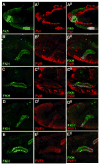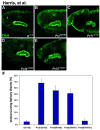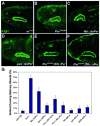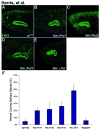Two ligands signal through the Drosophila PDGF/VEGF receptor to ensure proper salivary gland positioning
- PMID: 17462868
- PMCID: PMC2680691
- DOI: 10.1016/j.mod.2007.03.003
Two ligands signal through the Drosophila PDGF/VEGF receptor to ensure proper salivary gland positioning
Abstract
The Drosophila embryonic salivary gland is a migrating tissue that undergoes a stereotypic pattern of migration into the embryo. We demonstrate that the migratory path of the salivary gland requires the PDGF/VEGF pathway. The PDGF/VEGF receptor, Pvr, is strongly expressed in the salivary glands, and Pvr mutations cause abnormal ventral curving of the glands, suggesting that Pvr is involved in gland migration. Although the Pvr ligands, Pvf1 and Pvf2, have distinct expression patterns in the Drosophila embryo, mutations for either one of the ligands result in salivary gland migration defects similar to those seen in embryos that lack Pvr. Rescue experiments indicate that the PDGF/VEGF pathway functions autonomously in the salivary gland. The results of this study demonstrate that the Drosophila PDGF/VEGF pathway is essential for proper positioning of the salivary glands.
Figures





Similar articles
-
The Drosophila platelet-derived growth factor and vascular endothelial growth factor-receptor related (Pvr) protein ligands Pvf2 and Pvf3 control hemocyte viability and invasive migration.J Biol Chem. 2013 Jul 12;288(28):20173-83. doi: 10.1074/jbc.M113.483818. Epub 2013 Jun 4. J Biol Chem. 2013. PMID: 23737520 Free PMC article.
-
A blood-borne PDGF/VEGF-like ligand initiates wound-induced epidermal cell migration in Drosophila larvae.Curr Biol. 2009 Sep 15;19(17):1473-7. doi: 10.1016/j.cub.2009.07.019. Epub 2009 Jul 30. Curr Biol. 2009. PMID: 19646875 Free PMC article.
-
Different Wnt signals act through the Frizzled and RYK receptors during Drosophila salivary gland migration.Development. 2007 Jun;134(11):2017-25. doi: 10.1242/dev.001164. Development. 2007. PMID: 17507403
-
Regulation and formation of the Drosophila salivary glands.Ann N Y Acad Sci. 1998 Apr 15;842:55-69. doi: 10.1111/j.1749-6632.1998.tb09632.x. Ann N Y Acad Sci. 1998. PMID: 9599294 Review.
-
Salivary gland branching morphogenesis.Differentiation. 2006 Sep;74(7):349-64. doi: 10.1111/j.1432-0436.2006.00088.x. Differentiation. 2006. PMID: 16916374 Review.
Cited by
-
Secrets of secretion-How studies of the Drosophila salivary gland have informed our understanding of the cellular networks underlying secretory organ form and function.Curr Top Dev Biol. 2021;143:1-36. doi: 10.1016/bs.ctdb.2020.09.005. Epub 2020 Nov 19. Curr Top Dev Biol. 2021. PMID: 33820619 Free PMC article.
-
Building and specializing epithelial tubular organs: the Drosophila salivary gland as a model system for revealing how epithelial organs are specified, form and specialize.Wiley Interdiscip Rev Dev Biol. 2014 Jul-Aug;3(4):281-300. doi: 10.1002/wdev.140. Epub 2014 May 23. Wiley Interdiscip Rev Dev Biol. 2014. PMID: 25208491 Free PMC article. Review.
-
New diagnostic markers in salivary gland tumors.Eur Arch Otorhinolaryngol. 2014 Jul;271(7):1999-2007. doi: 10.1007/s00405-013-2740-5. Epub 2013 Oct 4. Eur Arch Otorhinolaryngol. 2014. PMID: 24091559
-
Overexpression screen in Drosophila identifies neuronal roles of GSK-3 beta/shaggy as a regulator of AP-1-dependent developmental plasticity.Genetics. 2008 Dec;180(4):2057-71. doi: 10.1534/genetics.107.085555. Epub 2008 Oct 1. Genetics. 2008. PMID: 18832361 Free PMC article.
-
Drosophila FoxL1 non-autonomously coordinates organ placement during embryonic development.Dev Biol. 2016 Nov 15;419(2):273-284. doi: 10.1016/j.ydbio.2016.09.007. Epub 2016 Sep 13. Dev Biol. 2016. PMID: 27618755 Free PMC article.
References
-
- Andrew DJ, Henderson KD, Seshaiah P. Salivary gland development in Drosophila melanogaster. Mech Dev. 2000;92:5–17. - PubMed
-
- Bonasio R, Scimone ML, Schaerli P, Grabie N, Lichtman AH, von Andrian UH. Clonal deletion of thymocytes by circulating dendritic cells homing to the thymus. Nat Immunol. 2006;7:1092–100. - PubMed
-
- Bradley PL, Haberman AS, Andrew DJ. Organ formation in Drosophila: specification and morphogenesis of the salivary gland. Bioessays. 2001;23:901–11. - PubMed
-
- Bradley PL, Myat MM, Comeaux CA, Andrew DJ. Posterior migration of the salivary gland requires an intact visceral mesoderm and integrin function. Dev Biol. 2003;257:249–62. - PubMed
-
- Bruckner K, Kockel L, Duchek P, Luque CM, Rorth P, Perrimon N. The PDGF/VEGF receptor controls blood cell survival in Drosophila. Dev Cell. 2004;7:73–84. - PubMed
Publication types
MeSH terms
Substances
Grants and funding
LinkOut - more resources
Full Text Sources
Molecular Biology Databases
Research Materials

